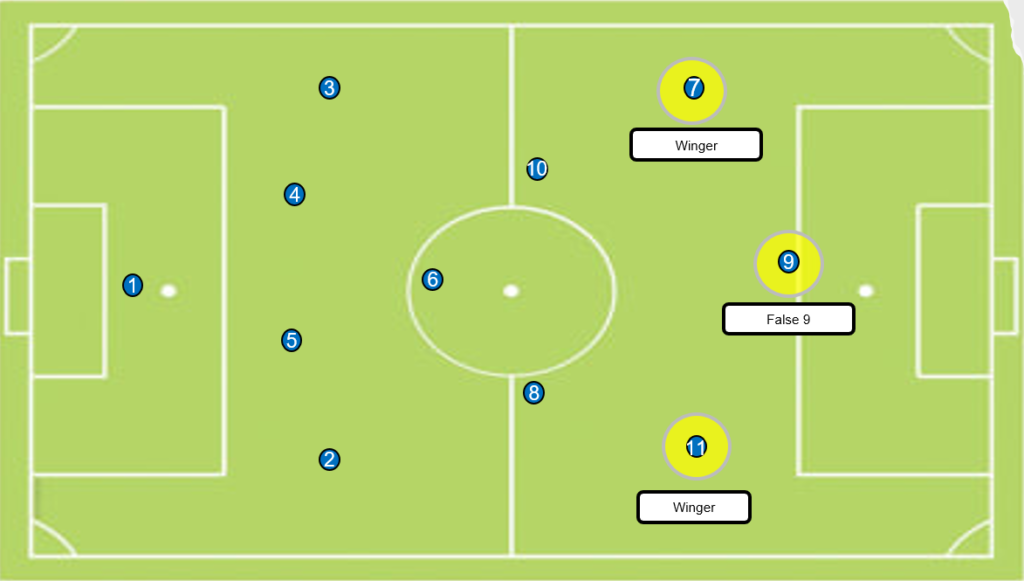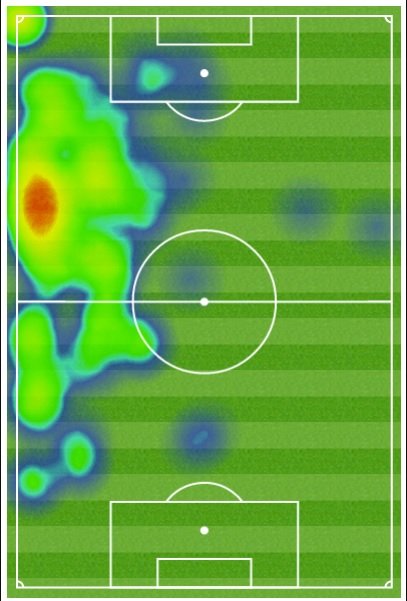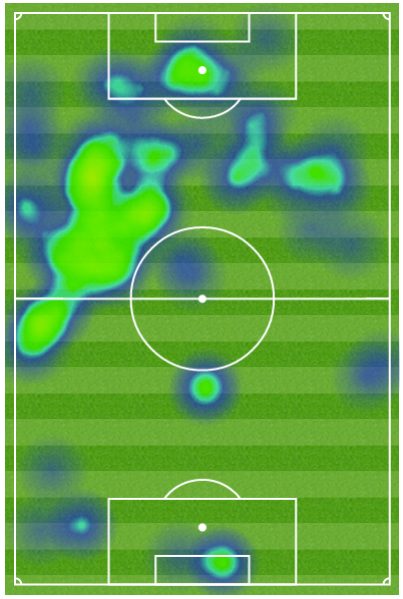Welcome to the 4th and final part of the article “The ideal player’s profile in each positional in a Positional Play”. In the 4th part, I will present the positions of the attacking trio, CF as false 9, and the wingers. The 1st Part had The Sweeper Goalkeeper role, and in the 2nd Part the central defenders and full-backs. The 3rd part was the turn of the three Midfielders. In the whole article, I have tried to present the ideal player’s profile in each position for a team who wishes to play positional play football.

The attacking trio (#7, #11, and #9)
The CF as false 9, classic and false wingers are terms used to better explain the tactical intentions of the wide players. Even though the starting positions may be the same, if anyone sees the heatmap of the wingers during the game, they will understand what the coach asks from them. So, the importance is not the name of the position but the tactical instructions the player has. Below you can see two heatmaps from two wingers. The first one acting as a classic wide player and the other one acting as an inside forward.


Wingers
This position is probably the one (along with the fullbacks) with the most tactical evolutions during the last few years. This position is one that Pep Guardiola gradually evolve from his time in Barcelona until today in Manchester City. The way Barcelona’s wingers game has nothing to do with the tactical intentions of Sterling and Mahrez at the Blues.
Sure, the inside forwards (wingers getting inside) existed long before but for 2008 – 2012. But that Barcelona it was a case of trying to accommodate great players into a system of play. Thierry Henry, Messi, Pedro, David Villa in Barcelona, Arjen Robber and Franck Ribery in Bayern Munich, and Sterling, Mahrez, and Greelish in Manchester City are all players who under Pep Guardiola were used in the specific position.
All of them were great but on the pitch, they all had different tactical intentions. The team’s formation, the team’s characteristics, and the individual player’s skills forced each time Guardiola to give them different tactical instructions.
Subsequently, we can only conclude that the winger’s main tasks (common for all mentioned before) are that of support and dynamic movements in the attacking third when the ball is circulating outside the box. The way each player will execute these movements varies depending on their individual skills.
In all cases, this is a player who can excel in 1 v 1 situations, drive with the ball forward with pace, has a dynamic approach and attacking mind to off-the-ball movements, and can both assist and score goals.
Acting as a 2nd striker
Wingers who can play in inside positions and support as 2nd strikers the forward are valuable. Especially in a crossing situation, the opposite winger is expected to occupy the space in the 2nd post. They can contribute with goals and assists.
This also will disorganize the opponent’s back 4 line creating spaces in wide areas for other players to operate. Forward runs behind the opponent’s back lines are expected movements from these inside forwards.
When a winger is playing in a more classical way by staying on the sideline, he creates spaces inside for the advanced midfielders to operate between the lines and in half spaces. Also, this position gives the opportunities for many underlaps that in modern football are so difficult to defend against.
Characteristics of the ideal player’s profile
- Exceptional technical skills (driving with the ball, dribbling 1 v 1, shooting, crossing)
- Understand the space and time
- Move without the ball (behind the opponent’s lines)
- Understand the meaning of Positional Superiority (especially for inside wingers)
- Feel comfortable playing between the lines
Main roles of the ideal player’s profile
- Become 2nd Forward
- Defend zonally in the midfield (4 – 4 – 2 and 4 – 5 – 1)
- Stay wide to create spaces inside or get inside and create spaces outside
- Produce assist or 2nd assists
- Scorer
CF as false 9 or central forward
The CF as false 9 is a role widely covered in the media with the attention that Messi received at Barcelona during Pep Guardiola era. This was also Fabrega’s role during the 2012 European Cup when he was on the pitch.
Simply, this should be a player that can win matches through creativity and confidence. The level of risk taken by this player is considered much higher than others during the ball circulation. Messi gave the ball away more than any other player in Europe in the top 5 leagues during the 2011 season. The majority of his attacking actions were to drop deep, receive a pass, attract pressure, give it back and move to another position.
This does not indicate that Messi is unable not keep the ball. Messi is expected to attempt dribbles in areas with greater benefit for the team, near the penalty box, or in wide areas.
This player should attract the opponent’s attention due to his high quality (either in dribbling, scoring, assisting, etc.) If the defenders, when he drops in the midfield, choose to follow him, they will leave gaps behind. These gaps can be exploited by the wingers or attacking midfielders. If the defenders choose to not follow him, the false 9 will create numerical overloads in the center of the pitch.
Ideal examples
There are a number of examples of the variety of players who could fit this role as a technical number 9. Denis Bergkamp, Karim Benzema, and Alexis Sanchez are players who showed the last 20 years that are capable to play this role.
Using the false 9 in the wrong way
However, if the wrong type of layer profile is selected to play this CF as false 9 role, the player becomes ineffective. The approach to the positional play style falls to pieces. There are not too many players who can implement the specific role in perfection. The characteristics of Messi or Suarez are rare. This kind of player should be completed, having both forward’s and midfielders skills in perfection. To know when to drop deep and when to keep a higher position. To know when and where to create space for himself or for his teammates.
Aside from the ability to create a link during the ball circulation, the player should also play a key role in all phases. His behavior in the pressing transitions and defending phase is also vital.
Characteristics of the ideal player’s profile
- Exceptional technical skills (dribbling 1 v 1, shooting, passing, and receiving)
- Use of both feets
- Understand the space and time
- Move without the ball and drop back
- Understand the meaning of Positional Superiority
- Feel comfortable playing between the lines
Main roles of the ideal player’s profile
- Striker in the penalty box
- Act as an outside-the-box striker
- Defend zonally in the midfield (4 – 4 – 2 and 4 – 5 – 1)
- Drop back to become a midfielder – create overloads centrally
- Produce assists
- Scorer
Conclusion
The attacking trio has no standard form, characteristics, and tactical behavior. All of them have to do with coaches’ philosophy, the team’s abilities, and players’ individual skills. What has become apparent is that there is much flexibility in the player profiles. Except for the individual characteristics, they should also be able to communicate them complement each other. The key point of these parts is that while the coach must seek suitable players for his philosophy, what will be the end result has to do only with the player’s behavior and how he feels on the pitch.


Everything is very open with a clear clarification of the issues. It was truly informative. Your website is very useful. Thanks for sharing!